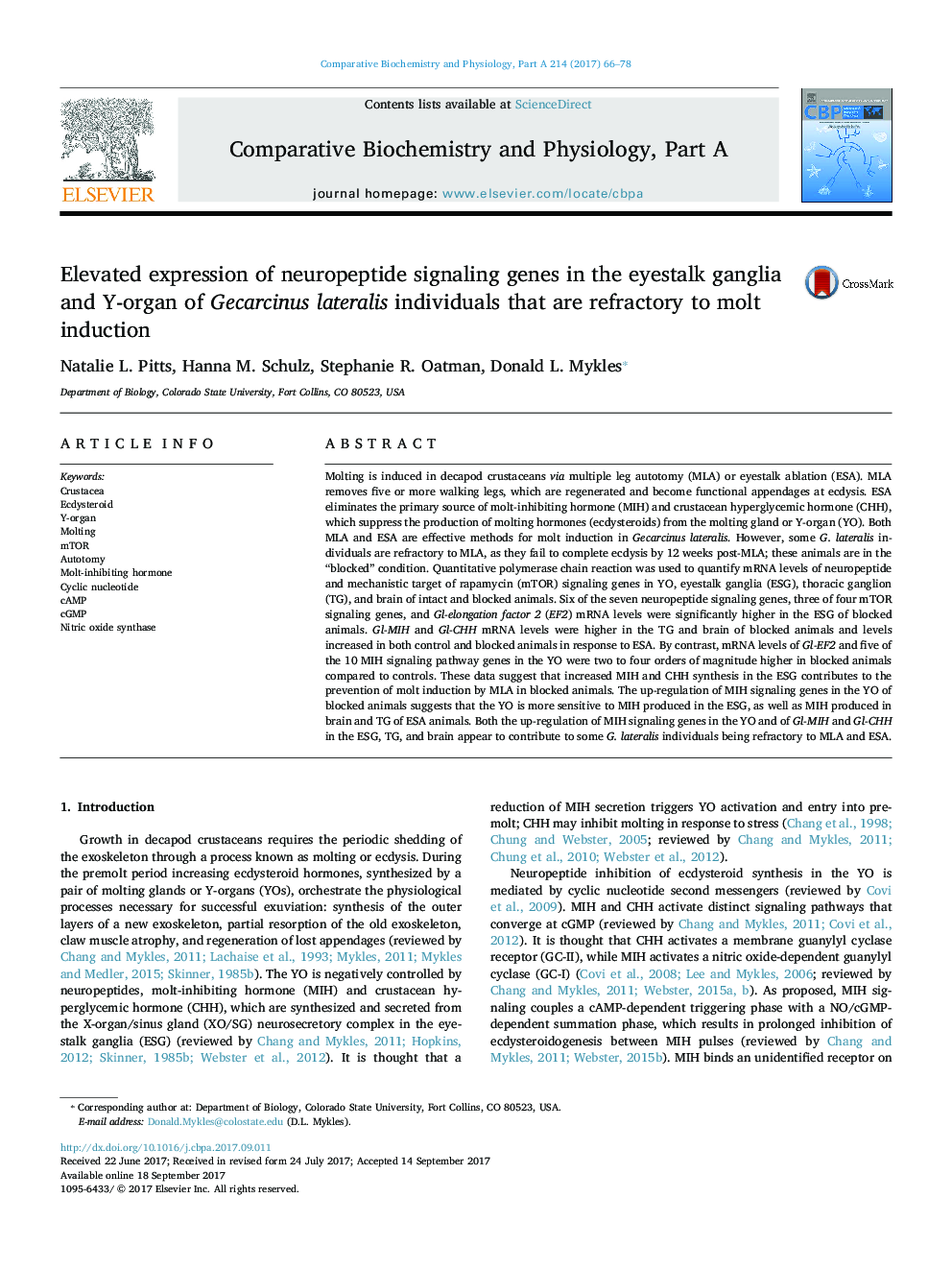| کد مقاله | کد نشریه | سال انتشار | مقاله انگلیسی | نسخه تمام متن |
|---|---|---|---|---|
| 5510233 | 1538973 | 2017 | 13 صفحه PDF | دانلود رایگان |
عنوان انگلیسی مقاله ISI
Elevated expression of neuropeptide signaling genes in the eyestalk ganglia and Y-organ of Gecarcinus lateralis individuals that are refractory to molt induction
دانلود مقاله + سفارش ترجمه
دانلود مقاله ISI انگلیسی
رایگان برای ایرانیان
کلمات کلیدی
موضوعات مرتبط
علوم زیستی و بیوفناوری
بیوشیمی، ژنتیک و زیست شناسی مولکولی
زیست شیمی
پیش نمایش صفحه اول مقاله

چکیده انگلیسی
Molting is induced in decapod crustaceans via multiple leg autotomy (MLA) or eyestalk ablation (ESA). MLA removes five or more walking legs, which are regenerated and become functional appendages at ecdysis. ESA eliminates the primary source of molt-inhibiting hormone (MIH) and crustacean hyperglycemic hormone (CHH), which suppress the production of molting hormones (ecdysteroids) from the molting gland or Y-organ (YO). Both MLA and ESA are effective methods for molt induction in Gecarcinus lateralis. However, some G. lateralis individuals are refractory to MLA, as they fail to complete ecdysis by 12Â weeks post-MLA; these animals are in the “blocked” condition. Quantitative polymerase chain reaction was used to quantify mRNA levels of neuropeptide and mechanistic target of rapamycin (mTOR) signaling genes in YO, eyestalk ganglia (ESG), thoracic ganglion (TG), and brain of intact and blocked animals. Six of the seven neuropeptide signaling genes, three of four mTOR signaling genes, and Gl-elongation factor 2 (EF2) mRNA levels were significantly higher in the ESG of blocked animals. Gl-MIH and Gl-CHH mRNA levels were higher in the TG and brain of blocked animals and levels increased in both control and blocked animals in response to ESA. By contrast, mRNA levels of Gl-EF2 and five of the 10 MIH signaling pathway genes in the YO were two to four orders of magnitude higher in blocked animals compared to controls. These data suggest that increased MIH and CHH synthesis in the ESG contributes to the prevention of molt induction by MLA in blocked animals. The up-regulation of MIH signaling genes in the YO of blocked animals suggests that the YO is more sensitive to MIH produced in the ESG, as well as MIH produced in brain and TG of ESA animals. Both the up-regulation of MIH signaling genes in the YO and of Gl-MIH and Gl-CHH in the ESG, TG, and brain appear to contribute to some G. lateralis individuals being refractory to MLA and ESA.
ناشر
Database: Elsevier - ScienceDirect (ساینس دایرکت)
Journal: Comparative Biochemistry and Physiology Part A: Molecular & Integrative Physiology - Volume 214, December 2017, Pages 66-78
Journal: Comparative Biochemistry and Physiology Part A: Molecular & Integrative Physiology - Volume 214, December 2017, Pages 66-78
نویسندگان
Natalie L. Pitts, Hanna M. Schulz, Stephanie R. Oatman, Donald L. Mykles,